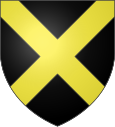Krautergersheim
| Krautergersheim | ||
|---|---|---|

|
|
|
| region | Grand Est | |
| Department | Bas-Rhin | |
| Arrondissement | Sélestat-Erstein | |
| Canton | Obernai | |
| Community association | Pays de Sainte-Odile | |
| Coordinates | 48 ° 29 ′ N , 7 ° 34 ′ E | |
| height | 149-159 m | |
| surface | 6.37 km 2 | |
| Residents | 1,680 (January 1, 2017) | |
| Population density | 264 inhabitants / km 2 | |
| Post Code | 67880 | |
| INSEE code | 67248 | |
 Half-timbered house in Krautergersheim |
||
Krautergersheim is a French commune with 1680 inhabitants (as of January 1, 2017) in the Bas-Rhin department in the Grand Est region (until 2015 Alsace ). It belongs to the municipality of Pays de Sainte-Odile .
history
Traces of settlement from the Hallstatt period (1200-475 BC), from the Gallo-Roman period (52 BC to the 5th century) and from the subsequent Merovingian period (5th to 8th centuries) have been found in the municipality of Krautergersheim . Century) found.
Documents confirm that the monasteries Murbach (735), Fulda (778) and Baumgarten (1181) as well as the convent Odilienberg (1050) had possessions in Krautergersheim.
From the 14th century to the French Revolution (1789–1799) the place was owned by several noble families. The middle line of the barons of Berckheim died out in the male line on November 12, 1787 with the grandson of their founder, Franz Samuel, French colonel, Stettmeister to Strasbourg and rector of the university there. The Berckheims owned a castle there, which went down in 1815 and was later acquired by Bernard-Frédéric de Turckheim (1752–1831), the temporary mayor of Strasbourg and husband of Lili Schönemann (1758–1817), the wealthy banker's daughter from Frankfurt am Main. The so-called central chapel, also called Chapelle de Turkheim , represents the remains of the former property. The couple's grave is located here. The building of this central chapel is privately owned by the de Turkheim de Dachstein family.
In 1587, during the Huguenot Wars (1562–1598) , the town was plundered and set on fire by passing mercenaries. During the Thirty Years' War (1618-1648) it was looted twice, first by Peter Ernst II von Mansfeld's troops, then by Swedish troops.
White cabbage and sauerkraut
At the beginning of the 16th century the word "herb" was placed at the beginning of the place name, as there is a village of the same name " Ergersheim " only about 10 kilometers north of Krautergersheim. The renaming of the place also shows that the production of sauerkraut and the cultivation of white cabbage have a long tradition in the municipality.
Krautergersheim calls itself the “Capital of Sauerkrauts” ( Capitale de la choucroute ) and regularly celebrates the “Sauerkrauts Festival” ( Fête de la choucroute ) on the last weekend in September of the year . The community is located on the " La Route de la Choucroute ", the sauerkraut road, which was launched in the early 1990s.
literature
- Edith Dörken: Lili Schönemann (1758–1817). In: Famous Frankfurt women. Verlag Otto Lembeck, Frankfurt 2008, ISBN 978-3-87476-557-2 , pp. 53-64.
- Le Patrimoine des Communes du Bas-Rhin. Flohic Editions, Volume 2, Charenton-le-Pont 1999, ISBN 2-84234-055-8 , pp. 911-913.
Movie
- Sauerkraut Festival Krautergersheim. Documentary, Germany, 2014, 29:40 min., Reports: Rolf Fritz, Ursula Schwedler, moderation: Hansy Vogt , production: SWR , series: Treffpunkt, first broadcast: October 13, 2014 on SWR, synopsis by ARD .
See also
Web links
- Fabian von Poser: Sauerkraut Festival in Alsace: All cabbage! In: Spiegel Online from September 14, 2014, with photo gallery .
- Les églises et chapelles du canton d'Obernai. Picture gallery, including the churches of Krautergersheim (French)
- "Türckheim, Anna Elisabeth (called Lili) Baroness of". Hessian biography. (As of October 5, 2013). In: Landesgeschichtliches Informationssystem Hessen (LAGIS).
Individual evidence
- ↑ Chapelle centrale - Krautergersheim ( Memento of the original from December 30, 2016 in the Internet Archive ) Info: The archive link has been inserted automatically and has not yet been checked. Please check the original and archive link according to the instructions and then remove this notice. in: fr.topic-topos.com , Chapelle Turkheim in Krautergernsheim, remainder of the Berckheim castle (or castle or country house) that went under in 1815, accessed on October 15, 2014.
- ↑ Sauerkraut Festival Krautergersheim in Alsace in: elsass-netz.de , accessed on October 15, 2014.
- ↑ Tobias Wiethoff: Season for sauerkraut. In: Handelszeitung . dated September 3, 2003.







